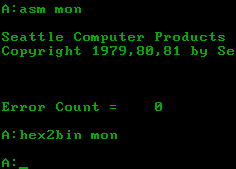 W
W86-DOS is a discontinued operating system developed and marketed by Seattle Computer Products (SCP) for its Intel 8086-based computer kit. Initially known as QDOS, the name was changed to 86-DOS once SCP started licensing the operating system in 1980.
 W
WApple Pascal is an implementation of Pascal for the Apple II and Apple III computer series. It's based on UCSD Pascal Just like other UCSD Pascal implementations, it ran on its own operating system.
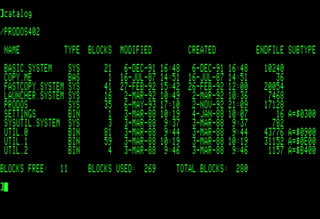 W
WProDOS is the name of two similar operating systems for the Apple II series of personal computers. The original ProDOS, renamed ProDOS 8 in version 1.2, is the last official operating system usable by all 8-bit Apple II series computers, and was distributed from 1983 to 1993. The other, ProDOS 16, was a stop-gap solution for the 16-bit Apple IIGS that was replaced by GS/OS within two years.
 W
WAtari DOS is the disk operating system used with the Atari 8-bit family of computers. Operating system extensions loaded into memory were required in order for an Atari computer to manage files stored on a disk drive. These extensions to the operating system added the disk handler and other file management features.
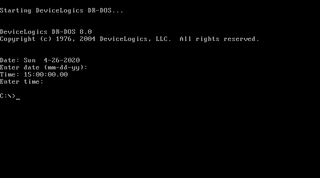 W
WDR-DOS is an operating system of the DOS family, written for IBM PC-compatible personal computers. It was originally developed by Gary A. Kildall's Digital Research and derived from Concurrent PC DOS 6.0, which was an advanced successor of CP/M-86. As ownership changed, various later versions were produced with names including Novell DOS and Caldera OpenDOS.
 W
WCommodore DOS, also known as CBM DOS, is the disk operating system used with Commodore's 8-bit computers. Unlike most other DOSes, which are loaded from disk into the computer's own RAM and executed there, CBM DOS is executed internally in the drive: the DOS resides in ROM chips inside the drive, and is run there by one or more dedicated MOS 6502 family CPUs. Thus, data transfer between Commodore 8-bit computers and their disk drives more closely resembles a local area network connection than typical disk/host transfers.
 W
WMS-DOS is an operating system for x86-based personal computers mostly developed by Microsoft. Collectively, MS-DOS, its rebranding as IBM PC DOS, and some operating systems attempting to be compatible with MS-DOS, are sometimes referred to as "DOS". MS-DOS was the main operating system for IBM PC compatible personal computers during the 1980s, from which point it was gradually superseded by operating systems offering a graphical user interface (GUI), in various generations of the graphical Microsoft Windows operating system.
 W
WMultiuser DOS is a real-time multi-user multi-tasking operating system for IBM PC-compatible microcomputers.
 W
WMultiuser DOS is a real-time multi-user multi-tasking operating system for IBM PC-compatible microcomputers.
 W
WMultiuser DOS is a real-time multi-user multi-tasking operating system for IBM PC-compatible microcomputers.
 W
WDR-DOS is an operating system of the DOS family, written for IBM PC-compatible personal computers. It was originally developed by Gary A. Kildall's Digital Research and derived from Concurrent PC DOS 6.0, which was an advanced successor of CP/M-86. As ownership changed, various later versions were produced with names including Novell DOS and Caldera OpenDOS.
 W
WThe Atari Portfolio is an IBM PC-compatible palmtop PC, released by Atari Corporation in June 1989. This makes it the world's first palmtop computer.
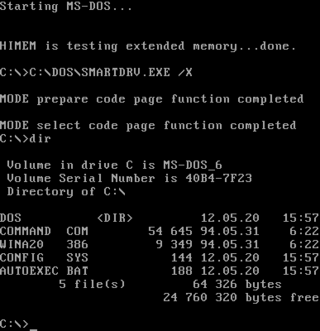 W
WDOS is a platform-independent acronym for Disk Operating System which later became a common shorthand for disk-based operating systems on IBM PC compatibles. DOS primarily consists of Microsoft's MS-DOS and a rebranded version under the name IBM PC DOS, both of which were introduced in 1981. Later compatible systems from other manufacturers include DR DOS (1988), ROM-DOS (1989), PTS-DOS (1993), and FreeDOS (1998). MS-DOS dominated the IBM PC compatible market between 1981 and 1995.
 W
WDOS Plus was the first operating system developed by Digital Research's OEM Support Group in Newbury, Berkshire, UK, first released in 1985. DOS Plus 1.0 was based on CP/M-86 Plus combined with the PCMODE emulator from Concurrent PC DOS 4.11. While CP/M-86 Plus and Concurrent DOS 4.1 still had been developed in the United States, Concurrent PC DOS 4.11 was an internationalized and bug-fixed version brought forward by Digital Research UK. Later DOS Plus 2.x issues were based on Concurrent PC DOS 5.0 instead. In the broader picture, DOS Plus can be seen as an intermediate step between Concurrent CP/M-86 and DR DOS.
 W
WDOS XL is a discontinued Disk Operating System (DOS) written by Paul Laughton, Mark Rose, Bill Wilkinson, and Mike Peters and published by Optimized Systems Software for the Atari 8-bit family of home computers. It was designed to be compatible with Atari DOS which came shipped with Atari, Inc.'s disk drives.
 W
WDR-DOS is an operating system of the DOS family, written for IBM PC-compatible personal computers. It was originally developed by Gary A. Kildall's Digital Research and derived from Concurrent PC DOS 6.0, which was an advanced successor of CP/M-86. As ownership changed, various later versions were produced with names including Novell DOS and Caldera OpenDOS.
 W
WDR-DOS is an operating system of the DOS family, written for IBM PC-compatible personal computers. It was originally developed by Gary A. Kildall's Digital Research and derived from Concurrent PC DOS 6.0, which was an advanced successor of CP/M-86. As ownership changed, various later versions were produced with names including Novell DOS and Caldera OpenDOS.
 W
WDR-DOS is an operating system of the DOS family, written for IBM PC-compatible personal computers. It was originally developed by Gary A. Kildall's Digital Research and derived from Concurrent PC DOS 6.0, which was an advanced successor of CP/M-86. As ownership changed, various later versions were produced with names including Novell DOS and Caldera OpenDOS.
 W
WDR-DOS is an operating system of the DOS family, written for IBM PC-compatible personal computers. It was originally developed by Gary A. Kildall's Digital Research and derived from Concurrent PC DOS 6.0, which was an advanced successor of CP/M-86. As ownership changed, various later versions were produced with names including Novell DOS and Caldera OpenDOS.
 W
WThe FLEX single-tasking operating system was developed by Technical Systems Consultants (TSC) of West Lafayette, Indiana, for the Motorola 6800 in 1976.
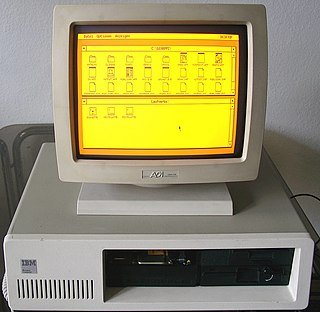 W
WGEM is an operating environment which was created by Digital Research (DRI) since 1984 for use with the DOS operating system on Intel 8088 and Motorola 68000 microprocessors.
 W
WThe Hyperion is an early portable computer that vied with the Compaq Portable to be the first portable IBM PC compatible. It was marketed by Infotech Cie of Ottawa, a subsidiary of Bytec Management Corp., who acquired the designer and manufacturer Dynalogic in January 1983. In 1984 the design was licensed by Commodore International in a move that was forecast as a "radical shift of position" and a signal that Commodore would soon dominate the PC compatible market. Despite computers being "hand-assembled from kits" provided by Bytec and displayed alongside the Commodore 900 at a German trade show as their forthcoming first portable computer, it was never sold by Commodore and some analysts downplayed the pact. The Hyperion was shipped in January 1983 at C$4995, two months ahead of the Compaq Portable.
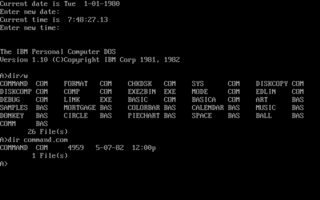 W
WIBM PC DOS, an acronym for IBM personal computer disk operating system, is a discontinued operating system for the IBM Personal Computer, manufactured and sold by IBM from the early 1980s into the 2000s.
 W
WMiNT is Now TOS (MiNT) is a free software alternative operating system kernel for the Atari ST system and its successors. It is a multi-tasking alternate to TOS and MagiC. Together with the free system components fVDI device drivers, XaAES graphical user interface widgets, and TeraDesk file manager, MiNT provides a free TOS compatible replacement OS that can multitask.
 W
WMS-DOS is an operating system for x86-based personal computers mostly developed by Microsoft. Collectively, MS-DOS, its rebranding as IBM PC DOS, and some operating systems attempting to be compatible with MS-DOS, are sometimes referred to as "DOS". MS-DOS was the main operating system for IBM PC compatible personal computers during the 1980s, from which point it was gradually superseded by operating systems offering a graphical user interface (GUI), in various generations of the graphical Microsoft Windows operating system.
 W
WMS-DOS 4.0 was a multitasking release of MS-DOS developed by Microsoft based on MS-DOS 2.0. Lack of interest from OEMs, particularly IBM, led to it being released only in a scaled-back form. It is sometimes referred to as European MS-DOS 4.0, as it was primarily used there. It should not be confused with PC DOS 4.00 or MS-DOS 4.01 and later, which did not contain the multi-tasking features.
 W
WMultiuser DOS is a real-time multi-user multi-tasking operating system for IBM PC-compatible microcomputers.
 W
WMS-DOS is an operating system for x86-based personal computers mostly developed by Microsoft. Collectively, MS-DOS, its rebranding as IBM PC DOS, and some operating systems attempting to be compatible with MS-DOS, are sometimes referred to as "DOS". MS-DOS was the main operating system for IBM PC compatible personal computers during the 1980s, from which point it was gradually superseded by operating systems offering a graphical user interface (GUI), in various generations of the graphical Microsoft Windows operating system.
 W
WDR-DOS is an operating system of the DOS family, written for IBM PC-compatible personal computers. It was originally developed by Gary A. Kildall's Digital Research and derived from Concurrent PC DOS 6.0, which was an advanced successor of CP/M-86. As ownership changed, various later versions were produced with names including Novell DOS and Caldera OpenDOS.
 W
WDR-DOS is an operating system of the DOS family, written for IBM PC-compatible personal computers. It was originally developed by Gary A. Kildall's Digital Research and derived from Concurrent PC DOS 6.0, which was an advanced successor of CP/M-86. As ownership changed, various later versions were produced with names including Novell DOS and Caldera OpenDOS.
 W
WDR-DOS is an operating system of the DOS family, written for IBM PC-compatible personal computers. It was originally developed by Gary A. Kildall's Digital Research and derived from Concurrent PC DOS 6.0, which was an advanced successor of CP/M-86. As ownership changed, various later versions were produced with names including Novell DOS and Caldera OpenDOS.
 W
WPTS-DOS is a disk operating system, a DOS clone, developed in Russia by PhysTechSoft and Paragon Technology Systems.
 W
W86-DOS is a discontinued operating system developed and marketed by Seattle Computer Products (SCP) for its Intel 8086-based computer kit. Initially known as QDOS, the name was changed to 86-DOS once SCP started licensing the operating system in 1980.
 W
WMS-DOS is an operating system for x86-based personal computers mostly developed by Microsoft. Collectively, MS-DOS, its rebranding as IBM PC DOS, and some operating systems attempting to be compatible with MS-DOS, are sometimes referred to as "DOS". MS-DOS was the main operating system for IBM PC compatible personal computers during the 1980s, from which point it was gradually superseded by operating systems offering a graphical user interface (GUI), in various generations of the graphical Microsoft Windows operating system.
 W
WSISNE plus is a DOS 3.3 compatible clone created by Itautec and Scopus Tecnologia in Brazil prior to the end of the Market Reserve in 1991, which, at that time, forbid the importation of electronic equipment and software for general use. With the widespread use of MS-DOS after the importations were allowed, the SISNE plus OS was discontinued.
 W
WMS-DOS is an operating system for x86-based personal computers mostly developed by Microsoft. Collectively, MS-DOS, its rebranding as IBM PC DOS, and some operating systems attempting to be compatible with MS-DOS, are sometimes referred to as "DOS". MS-DOS was the main operating system for IBM PC compatible personal computers during the 1980s, from which point it was gradually superseded by operating systems offering a graphical user interface (GUI), in various generations of the graphical Microsoft Windows operating system.
 W
WThe Sophisticated Operating System, or SOS, is the primary operating system of the Apple III computer. SOS was developed by Apple Computer and released in October 1980.
 W
WSpartaDOS X is a disk operating system for the Atari 8-bit family of computers that closely resembles MS-DOS. It was developed and sold by ICD, Inc. in 1987-1993, and many years later picked up by the third-party community SpartaDOS X Upgrade Project, which still maintains the software.
 W
WFM Towns system is a Japanese variant of PC, built by Fujitsu from February 1989 to the summer of 1997. It started as a proprietary PC variant intended for multimedia applications and PC games, but later became more compatible with IBM PC compatibles. In 1993, the FM Towns Marty was released, a game console compatible with existing FM Towns games.
 W
WTRSDOS is the operating system for the Tandy TRS-80 line of eight-bit Zilog Z80 microcomputers that were sold through Radio Shack from 1977 through 1991. Tandy's manuals recommended that it be pronounced triss-doss. TRSDOS should not be confused with Tandy DOS, a version of MS-DOS licensed from Microsoft for Tandy's x86 line of personal computers (PCs).
 W
WDOS is a platform-independent acronym for Disk Operating System which later became a common shorthand for disk-based operating systems on IBM PC compatibles. DOS primarily consists of Microsoft's MS-DOS and a rebranded version under the name IBM PC DOS, both of which were introduced in 1981. Later compatible systems from other manufacturers include DR DOS (1988), ROM-DOS (1989), PTS-DOS (1993), and FreeDOS (1998). MS-DOS dominated the IBM PC compatible market between 1981 and 1995.